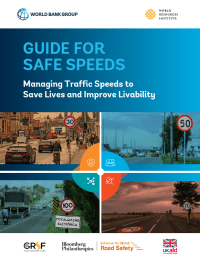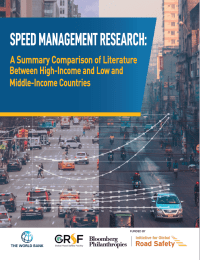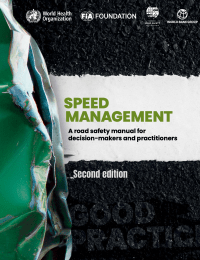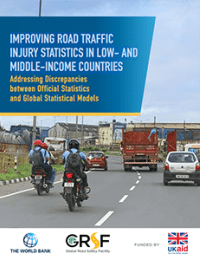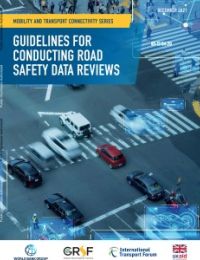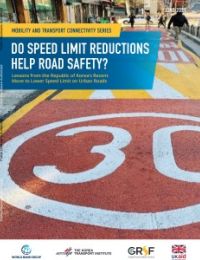Publications
1-10 of 19
-
Speed Management
Guide for Safe Speeds: Managing Traffic Speeds to Save Lives and Improve Livability
March 2024
-
Speed Management
Speed Management Research: A Summary Comparison of Literature Between High-Income and Low and Middle-Income Countries
February 2024
-
Speed Management
Speed Management: A Road Safety Manual for Decision-Makers and Practitioners (2nd ed.)
November 2023
-
Road Safety Data
Improving Road Traffic Injury Statistics in Low- and Middle-Income Countries
November 2023
- National decision-makers recognize the issue of underreporting but tend to dismiss higher estimates by global statistical models.
- Most countries use WHO GSRRS estimates.
- National health surveys and censuses in LMICs often contain relevant information, and minor modifications can greatly improve their usage for such measurements.
- Incorporating national health survey data into global statistical models can help resolve discrepancies and increase confidence in estimates.
- Integrating epidemiological data sources into global statistical models (GBD, GHE, GSRRS) to reduce discrepancies and increase confidence in their estimates.
- Including relevant questions in upcoming national data collections to facilitate epidemiological measurements of road traffic injuries.
- Encouraging local involvement in data production for better estimates.
- Enhancing coordination between the Institute for Health Metrics and Evaluation and the World Health Organization to improve estimates and reduce inconsistencies.
-
Speed Management
Road Crash Trauma, Climate Change, Pollution and the Total Costs of Speed: Six Graphs That Tell the Story
July 2022
-
-
Speed Management
Guide for Determining Readiness for Speed Cameras and Other Automated Enforcement
July 2022
-
To briefly identify the powerful practical value of AE in saving lives and reducing injuries.
-
To identify issues and criteria to be considered before commencing automated enforcement. To identify steps to be taken to achieve readiness for automated enforcement. To identify issues to improve existing automated enforcement systems.
-
To provide a checklist to ensure adequate consideration is given to issues to assess readiness to implement an AE system or improve an existing system.
- Evaluate the effectiveness of the reduced speed limits in terms of crash reduction through a before-after study.
- Examine if the speed limit change had different effects across different crash types, user types, and crash severities.
- Evaluate the impact of speed limit change on transit speed through a before-after assessment.
- Develop appropriate and actionable recommendations for departments of transportation in developing countries.

Speed is one of the main road safety risk factors and is universally recognized as the leading contributor to road fatalities and serious injuries. But there is good news: the speed problem is solvable. Interventions that are proven to be effective exist, and it is well understood where and how they should be applied.
The newly published “Guide for Safe Speeds: Managing Traffic Speeds to Save Lives and Improve Livability” outlines interventions that work and provides guidance on how to select and implement speed limits that are safe for all road users. It also explains how barriers to changing traffic speeds—which are often based on lack of knowledge or misunderstandings—can be overcome.
A primary feature of the guide is its comprehensiveness. The guide covers all types of roads—from city streets to inter-urban roads and motorways (existing or new); all types of road users—from vulnerable road users such as pedestrians and cyclists to heavy motorized traffic; all types of speed limit changes—from national general speed limits to localized changes based on risk factors; all types of challenging constraints—from lack of resources to lack of data; and all types of countries—from low-income to high-income.
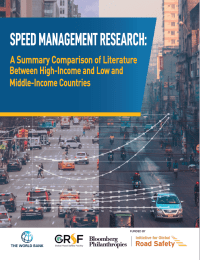
Low- and middle-income countries (LMICs) have been experiencing growth in vehicle travel and mobility but have not yet realized road safety gains experienced by high-income countries. Excessive and inappropriate speed is known to be a major cause of road crashes, injuries and deaths. Thus, speed management is considered a key initiative for improving road safety outcomes worldwide and has been applied successfully in most high-income countries.
Proven interventions do not necessarily have the same impacts in LMICs, or may not be feasible to apply, due significant differences in traffic mix, road user behavior, road design and vehicle standards.
This document summarizes current available knowledge about speed, its effects on safety, mobility and emissions, along with potential safety effectiveness of speed management initiatives in the LMIC context. Knowledge gaps for LMICs are clearly referenced for further consideration.
The knowledge summary provides a useful reference for practitioners wishing to inform themselves about traffic speeds, their selection and impacts on safety outcomes, mobility and emissions. The LMIC knowledge gaps will be useful in considering future research and data priorities.

The WHO, World Bank, FIA Foundation and Global Road Safety Partnership (GRSP) produced a series of good practice manuals, following the publication of the World report on road traffic injury prevention in 2004, which provide guidance on implementation of interventions to address specific risk factors in road safety. The topics covered in the initial series of manuals were: helmets (2006), drinking and driving (2007), speed management (2008), seat-belts and child restraints (2009), data systems (2010), pedestrian safety (2013), road safety legislation (2013), powered two- and three-wheeler safety (2017) and cyclist safety (2020).
Since the series of manuals was first published, the scientific evidence base relating to various risk factors and the effectiveness of interventions have continued expanding. Contemporary research has refined our knowledge about specific risk factors, such as distracted driving, and vehicle impact speed and risk of death for pedestrians. New issues and practices have arisen, such as a tropical helmet standard and an anti-braking control standard for motorcycles. New and existing interventions have been implemented and evaluated, with increasing application in LMICs. Research attention and policy response have also increasingly been applied to emerging road safety issues including e-bikes, drugs other than alcohol, fleet safety, urban mobility, micro mobility options, air and noise pollution, public transport and technological advances.
As a result of these developments, the good practice manuals required revision so that they can continue to be key references for road safety policy implementation and research. This is particularly important, given the emphasis placed on road safety within the framework of the 2030 Agenda for Sustainable Development and because of the global impetus to reduce road deaths and injuries, resulting from the declaration of the two United Nations’ Decades of Action for Road Safety (2011–2020 and 2021– 2030). The manuals have been revised to reflect these developments as they continue to be valuable resources providing evidence-based and cost-effective solutions to save lives and reduce injuries.
The management of speed remains one of the biggest challenges facing road safety practitioners around the world and calls for a concerted, long-term, multidisciplinary response. The speed at which a vehicle travels directly influences the risk of a crash as well as the severity of injuries sustained, and the likelihood of death resulting from that crash. This manual advocates for a strong and strategic approach to creating a Safe System, with speed management at its heart. Reducing motor vehicle speeds in areas where the road user mix includes a high volume of vulnerable road users, such as pedestrians and cyclists, and on non-divided rural roads, is especially important.
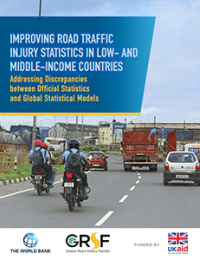
Road safety is a global health and economic issue that disproportionately affects low- and middle-income countries (LMICs). Precise data is crucial for understanding the full scope of the problem and developing effective interventions, but LMICs struggle to collect comprehensive data due to limited resources, underdeveloped health systems, and inconsistent data collection processes.
To overcome reporting gaps, three major global statistical models are utilized: The Institute for Health Metrics and Evaluation Global Burden of Disease (GBD) study, the World Health Organization (WHO) Global Status Reports on Road Safety (GSRRS), and WHO Global Health Estimates (GHE). However, discrepancies exist among these models and between them and official country statistics. They often estimate significantly higher road traffic fatalities and injuries than official LMIC statistics.
This GRSF study identifies the reasons behind statistical discrepancies and outlines strategies to strengthen modeling efforts. This involved qualitative research, a systematic review of national data availability, and four case studies in Brazil, Cambodia, Ethiopia, and Tanzania.
Key findings include:
Recommendations include:
To achieve the goal of the Second United Nations Decade of Action for Road Safety (reducing road traffic fatalities and injuries by 50% by 2030), substantial resources need to be allocated to road safety and accurate reporting and statistical estimates are required.

What is the real cost of speeding on people and the environment? These 6 graphs tell the story ⌵︎
The impacts of speed on the safety of road users, on congestion, on pollution, and on total costs of road travel are broadly misunderstood: often based on wrong assumptions, with effects taken as self-evident, failure to consider multiple impacts, externalization of costs by many stakeholders, and under-estimation of impacts (especially economic costs of higher speeds). The purpose of this brief note is to provide information on these relationships relevant to fundamental road transport policies, design, and operation. Well-established evidence shows the importance of managing travel speeds for road safety, for efficiency, for improved inclusion, and for greenhouse gas (GHG) and other emissions. Thus, speed management is a strong policy lever for the breadth of issues which must be addressed for sustainable mobility.
Reduced speeds of travel represent a major, yet under-appreciated, opportunity to improve safety, climate change impacts of travel, health, inclusion, the economy, and in some circumstances, congestion. Speed management can be achieved through a range of interventions including road infrastructure and vehicle technology, as well as enforcement and promotion.
The six graphs presented in this note tell a powerful story, across the range of these benefits of speed management.
This publication is also available in:
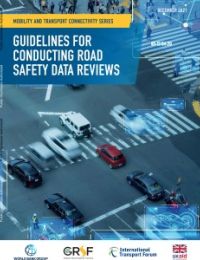
Download the document in English
Download the document in French
Download the document in Spanish
In many countries around the world, deficiencies in data or data quality impair evidence-based road safety policy making. While many countries collect road safety data, the collection is not necessarily comprehensive. Further, many countries can be unaware of data gaps in their system, which prevents them from soundly analyzing their road safety problems. Therefore, road safety data definitions and collection methods must converge into standard international criteria, thus allowing for comparisons in space - across countries - and in time.
This is the raison d’etre of regional road safety observatories, which have been developed, for example, in Latin America (OISEVI), Africa (ARSO), and Asia-Pacific (APRSO). They present an opportunity for joint regional efforts to improve, in a harmonized way, road safety data collection and analysis. Regional road safety observatories promote the adoption of a common set of road safety indicators based on common definitions and serve as an avenue to assist countries in improving the management of their crash data systems.
This document is designed to support reviewers in the assessment of road safety data collection; the complete range of safety data should be considered. This task can be complicated because collection of road safety data is often not achieved by activities dedicated to this purpose, but rather through piggybacks on other sources. For example, activity reports from police or hospitals are used to provide material for legal or medical purposes. The routines involved frequently have a long history in which gathering reliable and complete statistics has had secondary priority, at best. The various actors involved reflect the complex structure of a country’s judicial and executive system, which, generally, are not coordinated. Consequently, any review of the data collection process requires some “detective work.”

This guide has been prepared to assist a jurisdiction to determine the level of readiness to move to automated enforcement (AE). Speed cameras enforcing speed limits are a common application of AE and there are many systemic legal and operational elements that must be in place before AE can be effective. For example, an accurate image of a speeding vehicle, in the absence of robust driver licensing and vehicle registration systems, is of little road safety value. Importantly, automated speed enforcement should be considered as one part of a comprehensive speed management approach that includes road infrastructure and roadside policing as well. The management of speed is a fundamental element of the Safe System.
Aims of this document:
Other illegal behaviours, including disobeying a red light signal, mobile or cellular phone use, incorrect lane use, and non-restraint use can also be detected using an automated enforcement approach. However, this document applies specifically to automated speed enforcement, because speed management requires significant attention worldwide and plays a critical role in reducing road traffic deaths and injuries.
Document also available in French, Portuguese, Vietnamese and Spanish.
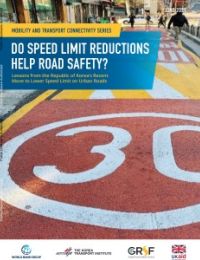
Significant research has been undertaken on how changes in speed limit—for example, the introduction of 30 kilometers per hour, or kph (20 miles per hour, or mph) speed limits—impact safety both when combined with, and without "traffic-calming" engineering treatments such as speed humps or raised platforms. However, most of the studies have been conducted in Australia or countries in Western Europe, with almost no recorded studies from Asia, Africa, the Americas, and Eastern Europe. Though it may be reasonable, a well-developed infrastructural environment such as that found in Korea would expect similar results as that of the western countries, a study originating in Asia could have a strong demonstration effect and prove very convincing for many Asian countries.
With this in mind, the main aim of this study is to present the findings from Korea’s reduced speed limits on safety performance and to support the establishment of suitable speed-management strategies based on a quantitative data-driven approach. The scope of the project was as follows:
To start, this report first provides a brief literature review on the concept of Safe System speed limits, and the effect of speed limit reductions as part of speed management in several countries, followed by a brief description of the evaluation methods for the before-after assessment. This is followed by a summary of the findings, a set of recommendations, limitations of this study, and finally, a capsule of future research that could be undertaken to either extend or follow up on the study.

Chi phí thực sự của việc chạy quá tốc độ đối với con người và môi trường là bao nhiêu? 6 biểu đồ sau đây sẽ cho biết câu chuyện
Tác động của tốc độ đối với sự an toàn của người tham gia giao thông, tình trạng tắc nghẽn, ô nhiễm và tổng chi phí đi lại trên đường bộ thường bị hiểu sai: thường dựa trên những giả định sai lầm, với những tác động được coi là hiển nhiên, không xem xét nhiều tác động, nhiều bên liên quan chuyển chi phí ra bên ngoài và đánh giá thấp tác động (đặc biệt là chi phí kinh tế khi chạy với tốc độ cao). Mục đích của bản ghi chú ngắn này là cung cấp thông tin về những mối quan hệ này có liên quan đến các chính sách, thiết kế và hoạt động cơ bản của giao thông đường bộ. Bằng chứng rõ ràng cho thấy tầm quan trọng của việc quản lý tốc độ di chuyển để đảm bảo an toàn giao thông, hiệu quả, cải thiện sự hòa nhập và khí nhà kính (GHG) cùng các khí thải khác. Do đó, quản lý tốc độ là đòn bẩy chính sách mạnh mẽ đối với nhiều vấn đề cần được giải quyết để có khả năng di chuyển bền vững.
Giảm tốc độ di chuyển là một cơ hội lớn nhưng chưa được đánh giá đúng mức để cải thiện sự an toàn, tác động của biến đổi khí hậu đối với giao thông, sức khỏe, sự hòa nhập, nền kinh tế và trong một số trường hợp là tình trạng tắc nghẽn. Quản lý tốc độ có thể đạt được thông qua một loạt các biện pháp can thiệp bao gồm cơ sở hạ tầng đường bộ và công nghệ xe cộ, cũng như thực thi và thúc đẩy.
Sáu biểu đồ được trình bày trong ghi chú này kể một câu chuyện mạnh mẽ, trong phạm vi các lợi ích của việc quản lý tốc độ.

¿Cuál es el costo real del exceso de velocidad para las personas y el medio ambiente? Estos 6 gráficos lo cuentan.
Los impactos de la velocidad en la seguridad de los usuarios de la vía, en la congestión, en la contaminación y en los costos totales de los viajes por carretera son ampliamente malinterpretados: a menudo se basan en suposiciones erróneas, con efectos que se toman como evidentes, no se consideran múltiples impactos, muchas partes interesadas externalizan los costos y se subestiman los impactos (especialmente los costos económicos de las velocidades más altas). El propósito de esta breve nota es proporcionar información sobre estas relaciones relevantes para las políticas fundamentales del transporte por carretera, el diseño y la operación. La evidencia bien establecida muestra la importancia de gestionar las velocidades de viaje para la seguridad vial, la eficiencia, la mejora de la inclusión y las emisiones de gases de efecto invernadero (GEI) y otras. Por lo tanto, la gestión de la velocidad es una fuerte palanca de política para la amplitud de cuestiones que deben abordarse para la movilidad sostenible.
La reducción de la velocidad de viaje representa una oportunidad importante, aunque subestimada, para mejorar la seguridad, los impactos del cambio climático de los viajes, la salud, la inclusión, la economía y, en algunas circunstancias, la congestión. La gestión de la velocidad se puede lograr mediante una serie de intervenciones, que incluyen la infraestructura vial y la tecnología de los vehículos, así como la aplicación de la ley y la promoción.
Los seis gráficos presentados en esta nota cuentan una historia poderosa sobre la gama de beneficios de la gestión de la velocidad.

